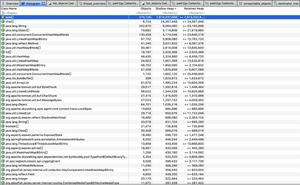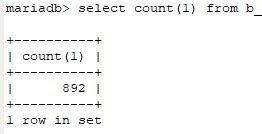记一次调优过程

jconsole 远程
增加jmx启动配置
/data/app/jdk1.8.0_151/bin/java
-Djava.rmi.server.hostname=127.0.0.1 -Dcom.sun.management.jmxremote -Dcom.sun.management.jmxremote.port=7018 -Dcom.sun.management.jmxremote.rmi.port=7019
-Dcom.sun.management.jmxremote.authenticate=false -Dcom.sun.management.jmxremote.ssl=false
-jar ./bussiness-0.0.1-SNAPSHOT.jar
-Xms2048m -Xmx2048m -Xmn1024g -Xss2m -XX:NewRatio=4 -XX:SurvivorRatio=4 -XX:ParallelGCThreads=4
-XX:+UseConcMarkSweepGC -XX:+CMSParallelRemarkEnabled -XX:+UseCMSCompactAtFullCollection -XX:CMSFullGCsBeforeCompaction=3 -XX:+UseParNewGC
-XX:+PrintGCDetails -XX:+PrintGCTimeStamps -XX:+PrintHeapAtGC -XX:+PrintGCApplicationConcurrentTime -XX:+PrintTenuringDistribution -XX:+PrintGCApplicationStoppedTime -Xloggc:../log/gc.log
总结GC统计
jstat -gcutil pid 【间隔时间】 【次数】
Cpu耗时过高
- top
查找到CPU占用率过高的PID - top -Hp PID
查找到子线程TID - printf "%x
" TID
TID 转16进制 - jstack -l PID | grep --color=auto -5 TID
获取JVM指定线程的堆栈信息
具体问题
正则表达式需要预编译
Q
使用过程中,使用了错误的方式处理: 每次都重新生成Pattern
Pattern pattern = Pattern.compile(datePattern1);Matcher match = pattern.matcher(sDate);
导致系统线程长时间RUNNING在
S
Pattern要定义为static final静态变量,以避免执行多次预编译.
private static final Pattern pattern = Pattern.compile(regexRule);private void func(...) {
Matcher m = pattern.matcher(content);
if (m.matches()) {
...
}
ArrayList&LinkedList&HashSet 的选择
Q
ArrayList: public boolean remove(Object o) {
if (o == null) {
for (int index = 0; index < size; index++)
if (elementData[index] == null) {
fastRemove(index);
return true;
}
} else {
for (int index = 0; index < size; index++)
if (o.equals(elementData[index])) {
fastRemove(index);
return true;
}
}
return false;
}
LinkedList:
public boolean remove(Object o) {
if (o == null) {
for (Node<E> x = first; x != null; x = x.next) {
if (x.item == null) {
unlink(x);
return true;
}
}
} else {
for (Node<E> x = first; x != null; x = x.next) {
if (o.equals(x.item)) {
unlink(x);
return true;
}
}
}
return false;
}
发现: 两者在remove指定对象时,都进行了遍历了List。
通过比较源码:ArrayList底层实现是数组;LinkedList则是双向链表(内部类Node封装外部Object)
private static class Node<E> {
E item;
Node<E> next;
Node<E> prev;
- get(int index):
ArrayList直接数组操作性能会好些;
LinkedList 需要遍历双向链表定位index下的Node。 - add(Object o) :
ArrayList可能要做扩容Arrays.copyOf(核心还是System.arraycopy)。
LinkedList则直接将原末尾Node的next指针指向新封装Node对象。 - add(int index, E element) :
ArrayList需要做System.arraycopy操作。
LinkedList最坏情况下需要遍历查找指定index上的Node做前后指针的重新指向。(最好情况:直接是在队尾,通过判定index = size) - 删除时,
ArrayList需要做System.arraycopy操作, remove(Object o) 需要提前遍历查找。
LinkedList无论是remove(int index)还是remove(Object o),都需要遍历双向链表查找指定的Node。但性能应该还是比ArrayList要快。
总结而言:
LinkedList的性能在修改时还是比ArrayList要好些。 但不足以支持当前大数据量的测试要求。
S
选择使用 HashSet!
hashSet的底层实现是通过HashMap来实现hashCode散列定位(hashMap的底层也还是数组,内部有Node来封装外部数据Object)。
static class Node<K,V> implements Map.Entry<K,V> {
final int hash;
final K key;
V value;
Node<K,V> next;
public boolean add(E e) { return map.put(e, PRESENT)==null;
}
public boolean remove(Object o) {
return map.remove(o)==PRESENT;
}
而hashMap在做查找、put、 remove等操作时,都会先通过对象hashCode计算定位在数组table上的具体存储位置。
public V put(K key, V value) { return putVal(hash(key), key, value, false, true);
}
public V remove(Object key) {
Node<K,V> e;
return (e = removeNode(hash(key), key, null, false, true)) == null ?
null : e.value;
}
static final int hash(Object key) {
int h;
return (key == null) ? 0 : (h = key.hashCode()) ^ (h >>> 16);
}
以上是 记一次调优过程 的全部内容, 来源链接: utcz.com/z/511438.html









